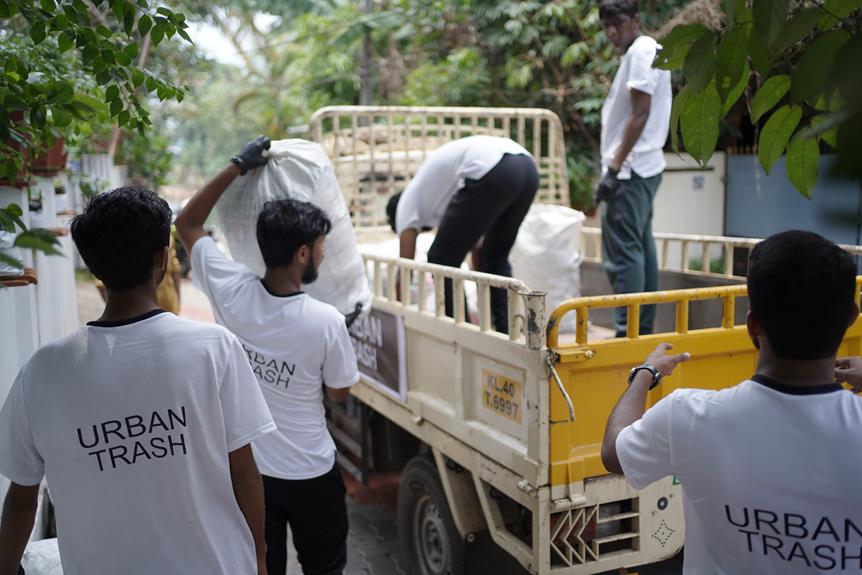Sustainable Approaches to Green Waste Management
Welcome to our exploration of sustainable approaches to green waste management.
In this article, we’ll delve into various methods that enable us to minimize waste, protect the environment, and create a more sustainable future.
From composting and recycling to waste-to-energy and vermicomposting, we’ll discover practical solutions that promote a circular economy and zero waste.
Join us on this journey as we uncover innovative ways to manage our green waste and make a positive impact on our planet.
Let’s embark on this sustainable adventure together!
Composting
Composting is an effective and eco-friendly method for managing green waste. It plays a vital role in reducing landfill waste and producing nutrient-rich soil for community gardens.
Industrial composting facilities are equipped to handle large quantities of organic waste, such as food scraps and yard trimmings, on a large scale. These facilities use controlled temperature and moisture levels to facilitate the decomposition process, resulting in high-quality compost.
The compost produced can then be used in community gardens, providing a sustainable source of nutrients for plants. Community gardens not only promote a sense of belonging and community engagement but also offer opportunities for individuals to grow their own food and connect with nature.
Recycling
Recycling plays a crucial role in sustainable waste management, offering numerous benefits for both the environment and society. By recycling materials such as paper, plastic, and glass, we can conserve natural resources, reduce greenhouse gas emissions, and minimize landfill space.
Furthermore, innovative recycling methods, such as advanced sorting technologies and upcycling, are continuously being developed to improve the efficiency and effectiveness of the recycling process.
Benefits of Recycling
One of the key benefits of implementing sustainable green waste management practices is the reduction of waste that’s sent to landfills. Recycling plays a crucial role in achieving this waste reduction and has many other environmental benefits.
Here are four reasons why recycling is beneficial:
- Conservation of resources: Recycling allows us to reuse materials such as paper, plastic, and glass, reducing the need for virgin resources and conserving energy.
- Reduction of pollution: By recycling, we can prevent the release of harmful gases and pollutants that occur during the extraction and production of new materials.
- Energy savings: Recycling requires less energy compared to manufacturing products from raw materials, leading to a significant reduction in greenhouse gas emissions.
- Landfill space preservation: Recycling helps to extend the lifespan of landfills by diverting waste from disposal sites.
Innovative Recycling Methods
Implementing sustainable green waste management practices involves exploring innovative methods for recycling, allowing us to further reduce waste and maximize resource utilization. By adopting these innovative waste management techniques, we can contribute to a healthier environment and a more sustainable future.
Eco-friendly recycling methods play a crucial role in this process. These methods focus on minimizing the impact of waste on the environment, while also promoting the efficient use of resources. One example of an innovative recycling method is composting, which involves decomposing organic waste and turning it into nutrient-rich soil.
Another method is upcycling, which involves transforming waste materials into new products with higher value. These innovative recycling methods not only divert waste from landfills but also provide economic opportunities and contribute to a circular economy.
Waste-to-Energy
We harness the power of organic waste through Waste-to-Energy processes. Waste-to-Energy is a sustainable approach that combines waste management technologies with renewable energy generation.
Here are four reasons why Waste-to-Energy is an effective solution for green waste management:
- Reduces landfill waste: Waste-to-Energy plants divert organic waste from landfills, reducing the amount of waste that ends up in these unsustainable and overcrowded sites.
- Generates clean energy: By converting organic waste into biogas or biofuels, Waste-to-Energy facilities produce renewable energy that we can use to power homes, businesses, and even vehicles.
- Reduces greenhouse gas emissions: Waste-to-Energy processes help mitigate climate change by capturing methane, a potent greenhouse gas, and converting it into energy. This reduces the overall carbon footprint of waste management.
- Promotes a circular economy: Waste-to-Energy contributes to a circular economy by extracting value from waste, creating a closed-loop system where waste is repurposed rather than discarded.
Source Separation
When it comes to green waste management, source separation offers numerous benefits. By separating our waste at the source, we can maximize recycling rates and minimize contamination.
However, implementing source separation can also present challenges, such as lack of awareness or infrastructure. Nevertheless, with proper education and investment in facilities, we can overcome these challenges, leading to a more sustainable and efficient waste management system.
Benefits of Source Separation
One of the key advantages of source separation is that it allows us to efficiently divert organic waste from landfills and promote a more sustainable waste management system. Here are four reasons why source separation is beneficial:
- Composting benefits: By separating organic waste at its source, we can easily collect and compost it. Composting not only reduces the amount of waste sent to landfills but also produces nutrient-rich soil amendments that we can use in agriculture and gardening.
- Waste reduction strategies: Source separation encourages individuals and communities to be more mindful of their waste. By actively participating in separating waste, we become more aware of our consumption habits and can make conscious decisions to reduce waste generation in the first place.
- Environmental preservation: Diverting organic waste from landfills helps reduce greenhouse gas emissions, as organic waste in landfills produces methane, a potent greenhouse gas. Source separation allows us to mitigate these harmful emissions and contribute to a healthier environment.
- Resource conservation: Separating waste at its source enables us to recover valuable resources, such as metals and plastics, through recycling. This reduces the need for raw material extraction and energy-intensive manufacturing processes, thereby conserving natural resources.
Implementation Challenges and Solutions
To tackle the implementation challenges of source separation, we need to address the logistical aspects of waste collection and educate the community about its importance.
Implementing source separation requires careful planning and coordination. One of the key challenges is establishing an efficient waste collection system that can handle different types of waste. This involves designing appropriate collection routes, ensuring sufficient collection bins, and training waste collection workers.
Additionally, community engagement plays a crucial role in the success of source separation. Educating the community about the benefits of source separation and providing clear guidelines on how to separate waste will encourage participation and compliance.
Implementation strategies such as public awareness campaigns, workshops, and incentive programs can help foster a sense of belonging and motivate individuals to actively participate in source separation efforts.
Vermicomposting
Our experience with vermicomposting has demonstrated the effectiveness of this sustainable approach to managing green waste. Vermicomposting is the process of using worms to decompose organic waste materials, such as food scraps and yard trimmings, into nutrient-rich compost.
Here are four vermicomposting techniques and the benefits they offer:
- Worm bins: These enclosed containers provide a controlled environment for worms to break down waste. They’re easy to maintain and we can keep them indoors or outdoors.
- Vermicomposting beds: These are outdoor beds where worms are added to organic waste. They allow for larger-scale composting and can accommodate a higher volume of waste.
- Worm towers: These vertical structures are placed directly in the ground and provide a habitat for worms to compost waste. They’re ideal for small spaces and gardens.
- Worm tea: This liquid fertilizer is produced by steeping worm castings in water. It’s rich in nutrients and can be used to nourish plants.
The benefits of vermicomposting include reducing waste sent to landfills, producing high-quality compost, and improving soil health. By engaging in vermicomposting, we can contribute to a more sustainable and environmentally friendly approach to waste management.
Anaerobic Digestion
Anaerobic digestion offers numerous benefits for sustainable waste management. It’s a natural process that converts organic waste into biogas and nutrient-rich digestate. We can apply this process to a wide variety of waste streams, including food waste, agricultural waste, and sewage sludge.
Benefits of Anaerobic Digestion
One of the significant advantages of utilizing anaerobic digestion in green waste management is its ability to efficiently convert a large quantity of organic waste into valuable resources. Here are the benefits of anaerobic digestion:
- Reduced greenhouse gas emissions: Anaerobic digestion helps in reducing methane emissions, a potent greenhouse gas, by capturing and utilizing it as biogas for energy production.
- Nutrient recycling: Through anaerobic digestion, organic waste is broken down by microorganisms, releasing valuable nutrients such as nitrogen and phosphorus that we can use as fertilizers for agriculture.
- Energy generation: The biogas produced during anaerobic digestion can be used to generate electricity and heat, providing a sustainable energy source.
- Carbon sequestration: Anaerobic digestion not only reduces methane emissions but also helps in diverting organic waste from landfills, preventing the release of carbon dioxide into the atmosphere.
Types of Waste Suitable for Anaerobic Digestion
To successfully implement anaerobic digestion as a green waste management strategy, it’s important to identify the types of waste suitable for this process.
One of the main types of waste that’s suitable for anaerobic digestion is food waste. Food waste can come from various sources, including households, restaurants, and grocery stores.
By diverting food waste from landfills and instead sending it to anaerobic digesters, we can effectively reduce methane emissions. Methane is a potent greenhouse gas that’s produced when organic waste decomposes in landfills.
Anaerobic digestion, on the other hand, captures and utilizes the methane produced during the process, turning it into a valuable energy source.
Role in Reducing Greenhouse Gases
Implementing anaerobic digestion as a green waste management strategy plays a crucial role in reducing greenhouse gases. Here’s why:
- Methane capture: Anaerobic digestion prevents methane, a potent greenhouse gas, from being released into the atmosphere. Instead, it captures and converts methane into biogas, which we can use as a renewable energy source.
- Carbon sequestration: By diverting organic waste from landfills, anaerobic digestion reduces the amount of organic matter that decomposes and produces methane. This helps to sequester carbon, preventing it from contributing to climate change.
- Energy production: Anaerobic digestion not only reduces greenhouse gas emissions but also generates renewable energy. Biogas produced during the process can be used to generate heat and electricity, further reducing reliance on fossil fuels.
- Circular economy: Anaerobic digestion promotes a circular economy by turning waste into a valuable resource. Instead of discarding it, we can transform organic waste into biogas and use it to offset fossil fuel consumption and reduce our carbon footprint.
Biogas Production
We are exploring the potential of utilizing biogas production as a sustainable approach to green waste management.
Biogas is a renewable energy source that can be derived from organic waste materials such as food scraps, agricultural residues, and sewage sludge. Biogas technology involves the anaerobic digestion of these waste materials, which produces a mixture of methane and carbon dioxide.
We can then use this biogas as a fuel for heating, electricity generation, and even vehicle fuel. Biogas utilization not only helps to reduce greenhouse gas emissions by capturing and utilizing methane, but it also provides a renewable energy source that can replace fossil fuels.
Circular Economy
Incorporating a circular economy approach into green waste management allows for the efficient utilization of resources and the reduction of waste. By adopting this approach, we can create a more sustainable and regenerative system that benefits both the environment and society.
Here are some key benefits of implementing a circular economy in waste management:
- Resource efficiency: A circular economy maximizes the value extracted from resources, reducing the need for extraction and minimizing waste generation.
- Reduced environmental impact: By keeping resources in use for longer periods through recycling and reuse, we can significantly decrease the environmental footprint of waste management.
- Economic opportunities: Circular economy practices can create new jobs, foster innovation, and stimulate economic growth in industries such as recycling and manufacturing.
- Climate change mitigation: Circular economy strategies help reduce greenhouse gas emissions by minimizing waste generation and the need for energy-intensive resource extraction and production.
However, transitioning to a circular economy also presents challenges, including the need for strong policy frameworks, technological advancements, and widespread behavior change. Overcoming these challenges is crucial to realizing the full potential of a circular economy in green waste management.
Upcycling
By embracing the concept of upcycling, we can further enhance the circular economy approach in green waste management. Upcycling involves transforming waste materials into new products of higher value, reducing the need for raw materials and minimizing waste generation.
There are numerous upcycling ideas that we can implement to make the most of our waste resources. For example, we can repurpose old clothing into trendy accessories or home decor items. We can transform discarded glass bottles into beautiful vases or lamps.
Upcycling benefits both the environment and society. It reduces the demand for new resources, decreases landfill waste, and promotes creativity and innovation. Additionally, upcycling can create job opportunities and contribute to local economies.
Zero Waste
To further enhance the circular economy approach in green waste management, our focus now shifts to zero waste practices. By adopting a zero waste lifestyle, we can significantly reduce our carbon footprint and contribute to a more sustainable future.
Here are four practical ways to embrace zero waste:
- Reduce: Minimize waste by only purchasing what we need and avoiding single-use items.
- Reuse: Give new life to items by finding creative ways to repurpose or repair them instead of throwing them away.
- Recycle: Properly sort and recycle materials to ensure that we can transform them into new products.
- Compost: Convert organic waste into nutrient-rich compost, reducing landfill waste and nourishing plants.
By incorporating these practices into our daily lives, we can make a positive impact on the environment and create a sense of belonging to the global sustainability movement.
Let’s join together in the journey towards zero waste!
Conclusion
It’s time for us to embrace sustainable approaches to green waste management.
By implementing composting, recycling, waste-to-energy solutions, source separation, vermicomposting, biogas production, circular economy practices, upcycling, and zero waste initiatives, we can make a significant positive impact on our environment.
Let’s join forces and become guardians of our planet, ensuring a greener and healthier future for generations to come. Together, we can turn the tide on waste and create a more sustainable world.
It’s time to make a change!






